“So we beat on, boats against the current, borne back ceaselessly into the past.” These famous words from The Great Gatsby aren’t just poetic—they carry deep emotional and spiritual meaning.
Like a dream we keep chasing, or a memory we can’t let go of, the symbols in this classic novel reflect our inner journeys, spiritual awakenings, and even our encounters with nature.
As a spiritual seeker or someone fascinated by emotional meaning in literature, you may wonder: Why does Gatsby look at the green light? Why are the colors so important? And how can we apply these symbols to understand our own lives better?
Let’s dive deeply into the symbolism in The Great Gatsby and uncover what these hidden messages can teach us about love, loss, identity, and even animal symbolism in our daily spiritual lives.
Color Symbolism in The Great Gatsby
Color plays a huge spiritual role in this novel. Each color paints more than just a scene—it expresses a soul emotion or life lesson.
- Green stands for hope and desire.
- Yellow reflects wealth but also decay.
- White shows innocence or fake purity.
- Blue gives off feelings of dreams, mystery, and sadness.
Color symbolism in The Great Gatsby helps us understand the characters’ true desires. Gatsby’s colorful world may look vibrant, but beneath it lies emptiness. Spiritually, it tells us that external shine doesn’t always equal inner peace.
Myrtle Flower Symbolism in The Great Gatsby
The myrtle flower is a hidden gem in the book’s symbol garden. In real life, myrtle represents love and devotion, often used in wedding bouquets. In the novel, the character Myrtle Wilson shares this name—but her life is far from romantic.
She tries to climb the social ladder through an affair with Tom Buchanan. Her life ends in tragedy, revealing how false love and broken devotion can lead to spiritual destruction.
The myrtle flower reminds us: real love grows slowly, rooted in truth—not illusion.
Color Symbolism in The Great Gatsby Quotes
Let’s explore a few quotes that show color symbolism’s deep meanings:
- “He stretched out his arms toward the dark water… Involuntarily I glanced seaward—and distinguished nothing except a single green light.”
- This quote shows how Gatsby’s dream is out of reach. The green light stands for a hopeful but empty future.
- This quote shows how Gatsby’s dream is out of reach. The green light stands for a hopeful but empty future.
- “Yellow cocktail music… floating in the garden.”
- Yellow feels cheerful here, but later represents corruption and greed (like the color of Gatsby’s car that kills Myrtle).
- Yellow feels cheerful here, but later represents corruption and greed (like the color of Gatsby’s car that kills Myrtle).
- “They were careless people, Tom and Daisy—they smashed up things and creatures.”
- The rich hide behind white clothes and houses, but their actions are destructive.
- The rich hide behind white clothes and houses, but their actions are destructive.
Color quotes in the novel reveal how the outer world masks inner truths—a powerful message for spiritual readers.
Yellow Symbolism in The Great Gatsby
Yellow appears often in the book—but it’s not just about money or gold. Yellow is fake gold. It symbolizes:
- Greed
- False success
- Decay beneath glamour
Gatsby’s yellow car becomes a symbol of death and ruin. The parties are golden on the surface, but spiritually empty. This warns us: chasing false light leads to emotional and spiritual emptiness.
Weather Symbolism in The Great Gatsby
Weather in Gatsby reflects spiritual moods. When big emotional moments happen, the weather changes:
- Rain during Gatsby and Daisy’s reunion shows nervousness and cleansing.
- Scorching heat during their argument reveals tension and boiling truths.
- The cold, gray autumn signals death, endings, and fading dreams.
Weather symbolism reminds us that nature mirrors our emotions. Just like how animal encounters can reflect inner growth, the sky in Gatsby acts as a spiritual mirror.
White Symbolism in The Great Gatsby
White may seem pure—but in Gatsby, it’s not that simple.
- Daisy wears white, lives in a white mansion, and drives a white car.
- But she is not innocent. She causes pain and hides behind her charm.
White symbolizes false purity—the kind that covers guilt, lies, and carelessness. Spiritually, it teaches us that not everything that looks light is full of light.
Blue Symbolism in The Great Gatsby
Blue is the color of dreams, sadness, and illusion.
- Gatsby’s blue gardens host parties full of fantasy.
- He wears a blue suit when trying to impress Daisy.
- The blue sky above the chaos reminds us of a world that keeps moving, no matter how we feel.
Blue connects us to the emotional depth and sadness behind Gatsby’s charm. It’s a soft symbol of spiritual longing and illusion.
Green Light Symbolism in The Great Gatsby
The green light at the end of Daisy’s dock is the novel’s most famous symbol. It means:
- Hope
- The American Dream
- Unreachable desire
For Gatsby, it’s Daisy. For us, it could be anything we long for—success, love, healing, or spiritual freedom. But sometimes, what we chase isn’t what we truly need.
The green light teaches us that chasing the past steals our present. Spiritually, it invites us to let go and return to the now.
3 Real-Life Scenarios That Reflect Gatsby’s Symbolism
1. Chasing a Dream That Hurts
A woman keeps going back to a toxic partner, believing that if she waits long enough, he’ll change. Like Gatsby, she’s holding onto a green light. Spiritually, this shows how attachment can blind us to the truth.
2. Wearing a Mask of Joy
A man constantly posts happy photos online, but inside, he feels lost. He’s living in white symbolism—pure on the outside, but aching within. His journey is to reconnect with his truth.
3. Flashy Success, Hidden Pain
A couple builds a luxury life but feel more distant each day. Their world is painted in yellow and blue—golden outside, but spiritually cold. Real connection begins when they look within, not outside.
FAQs About Symbolism in The Great Gatsby
1. Why is symbolism so important in The Great Gatsby?
Symbolism reveals deeper emotional and spiritual messages beyond the plot. It shows us the hidden feelings, fears, and dreams of the characters—and ourselves.
2. What does the green light truly mean?
It represents hope, dreams, and unreachable desires. It’s a symbol of the human tendency to live in the future, rather than the present.
3. How does weather act as a spiritual sign in the novel?
Weather mirrors emotions and signals change. Just like rain can be cleansing, or heat can reveal truth, nature in the novel reflects spiritual moods.
4. Is there animal symbolism in The Great Gatsby?
Yes, but subtly. Myrtle (named after a flower) is associated with nature and sacrificed, echoing how innocent lives are crushed by society. It’s a reminder of how fragile life becomes in the wrong hands.
5. What’s the spiritual lesson of Gatsby’s story?
It teaches us that living in illusion leads to emotional destruction. True peace comes from letting go, accepting reality, and embracing the now.
Conclusion:
The Great Gatsby isn’t just a novel about love and wealth—it’s a spiritual mirror. Every color, every storm, every dream holds meaning.
Gatsby’s journey is really our journey—one where we chase light, lose ourselves, and sometimes, find deeper truth in the process.




